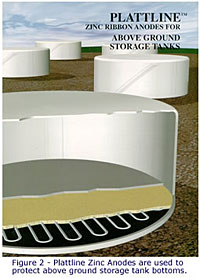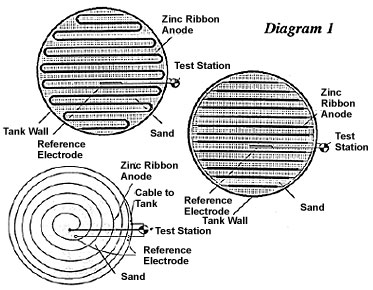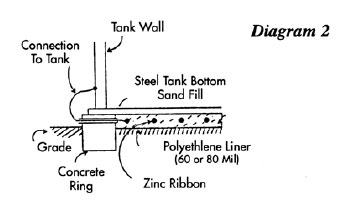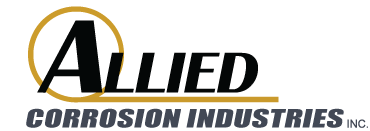1550 Cobb Industrial Dr. | P.O. Box 9098 | Marietta, GA 30065-2098
770-425-1355 (Phone) | 770-425-1354 (Fax) | info@alliedcorrosion.com (Email)
©2018 Allied Corrosion. All rights Reserved.
Made with ❤ by Mighty Good Marketing
Selected:
Plattline™ zinc ribbon anodes are used in a variety of applications. They are used in cathodic protection on buried pipelines, sacrificial cathodic protection of secondary bottoms on above ground storage tanks, as grounding mats for alienating current mitigation and in other corrosion protection applications. During installation procedures of Plattline™ zinc ribbon anodes in the above applications, it is necessary to connect Plattline™ to itself and to other main cables for full electrical interconnection of current flow. Plattline™ zinc ribbon anodes are manufactured with a steel wire core for electrical path continuity and for strength and handling of the product. This steel wire core is firmly bonded to the product.

Cathodic Protection (CP) is the application of direct current to reverse the natural tendency for metals to return to their natural condition as metal oxides (rust). CP prevents the corrosion process from occurring.
Corrosion occurs in the presence of moisture. In Above Ground Storage Tanks, it is important, both economically and environmentally, to protect tank bottoms from corrosion. The area under the tank bottom can become moist and can remain moist from ground moisture, under-tank condensation or seam leakage.
Present regulations make protection of the tank bottom desirable. Whether the tank bottom is the initial bottom of a new tank, a replacement bottom, or a double bottom, proper corrosion protection is important.
In the past, replacement bottoms were installed over the old bottom and welded to the old bottom at the tank wall. This procedure closes the corrosion circuit, making the new steel anodic to the old tank bottom, and in the process accelerating the corrosion process of the new metal.
Experience has shown that a properly designed and installed zinc ribbon anode system in the interstitial space between new and old tank bottoms is very effective at providing cathodic protection. This system has been recognized throughout the industry as the most cost effective and efficient method of corrosion control today.
Plattline™ Zinc Ribbon Anodes provide a simple and cost effective method of corrosion control for Above Ground Storage Tank bottoms. The zinc ribbon is self regulating which means that it will protect the steel tank bottom when the electrolyte (the sand) is conductive (moist) only on demand. When the demand decreases, the zinc ribbon output will decrease as well. No external power source is required.
Plattline™ is a continuous zinc ribbon and simple to install. No special tools are required and there is no need for constant monitoring or maintenance once the system is installed.
Features
Installation

Plattline T Zinc Ribbon Anode can be installed in several ways. It can be cut into lengths and connected by a lead wire along the tank bottom or it can be laid out in a spiral or serpentine fashion in a continuous length along the tank bottom. Each of these installation patterns is illustrated in Figure 2 on the next page and takes place in the sand electrolyte which is approximately four to six inches deep.
A liner is usually installed as secondary containment when retrofitting tanks with a new tank bottom. The anode is surrounded by approximately 6″ to 10″ of clean, dry sand and placed on top of the liner. There are several design configurations used for Plattline™ See Diagram 1. The specific design is determined by several factors – ease of installation, tank diameter and other engineering criteria. Usual spacing between the anode ribbon is 4 to 6 feet.

Once the zinc ribbon is installed, several zinc reference cells are placed in the sand electrolyte. Lead wires to the outside of the tank enable the tank owner to monitor the cathodic protection after installation and the tank is returned to service.Multi-meters, or voltmeters are used to take these electrical potential measurement readings. See Diagram 2. After installation of Plattline™, the new bottom is then welded in place, checked for leakage and repaired and the tank is returned to service.
Engineering & Economics
Government regulations, environmental issues and economics have made cathodic protection of above ground storage tank bottoms increasingly important. Internal corrosion occurs, generally, from crude and other stored products carrying water into the tank. The extraction process of the product itself will leave a water with an extremely high salt content, which settles to the bottom of the tank corroding the bottom from within. This circumstance can eventually cause product leakage – in fact, there are an estimated 20,000 leaking tanks each year in the United States alone. Repair costs, production down-time, product loss, clean-up costs and regulation penalty costs are just a few of the reasons that tank owners have turned to adequate corrosion prevention of AST Bottoms.
Plattline™ Zinc Ribbon Anodes are used over other galvanic anode or impressed current systems because the sand between the two bottoms will hold any moisture,thereby creating an electrolyte (a conductor) and corrosion can begin. The moisture is introduced by leaks in the tank or tank condensation. Independent laboratory testing has shown that the pitting rate in highly conductive sand could be great enough to perforate a tank bottom in as short as three (3)years. This electrolyte will activate Plattline™ Zinc Ribbon Anodes and galvanically protect the steel bottom. When the sand becomes dry, Plattline will regulate itself to only become active when the environment is corrosive. Magnesium has a much stronger driving potential, is not self regulating and will consume itself at a much greater rate, thus shortening the life of the application. Also, magnesium is not as flexible a material and does not easily lend itself to various design configurations.
Conclusions
In the actual monitoring of a 140 ft diameter tank with a double bottom, one major oil company concluded that:

1550 Cobb Industrial Dr. | P.O. Box 9098 | Marietta, GA 30065-2098
770-425-1355 (Phone) | 770-425-1354 (Fax) | info@alliedcorrosion.com (Email)
Made with ❤ by Mighty Good Marketing
